Key takeaways
- Activist teacher resources empower educators to inspire critical thinking and social awareness, transforming students into active advocates for change.
- STEM education promotes hands-on projects that connect theoretical concepts to real-world issues, enhancing problem-solving skills and fostering a spirit of collaboration among students.
- Designing STEM projects for activism involves addressing local and global challenges, instilling a sense of purpose, and encouraging discussions about social justice.
- Overcoming challenges like limited resources and varied skill levels can spark creativity and resilience, making every learner’s success a priority in hands-on STEM education.

Understanding activist teacher resources
Activist teacher resources are more than just lesson plans or worksheets; they are tools that empower educators to challenge the status quo. I remember the first time I used such materials—I felt a rush of purpose, knowing I was not just teaching facts but inspiring critical thinking and social awareness. Have you ever considered how access to these resources might change the way students see themselves and the world?
These resources often bring real-world issues into the classroom, bridging the gap between academic content and lived experiences. From my experience, this connection sparks a deeper curiosity and engagement in students who might otherwise feel detached from traditional subjects. Isn’t it time we rethink the role of education beyond memorization, focusing instead on active, meaningful learning?
What excites me most is the potential for these resources to foster a community of learners who are both aware and active. When I tap into activist teacher materials, I see students transform from passive recipients to passionate advocates for change. Doesn’t teaching become far more rewarding when it moves in this direction?
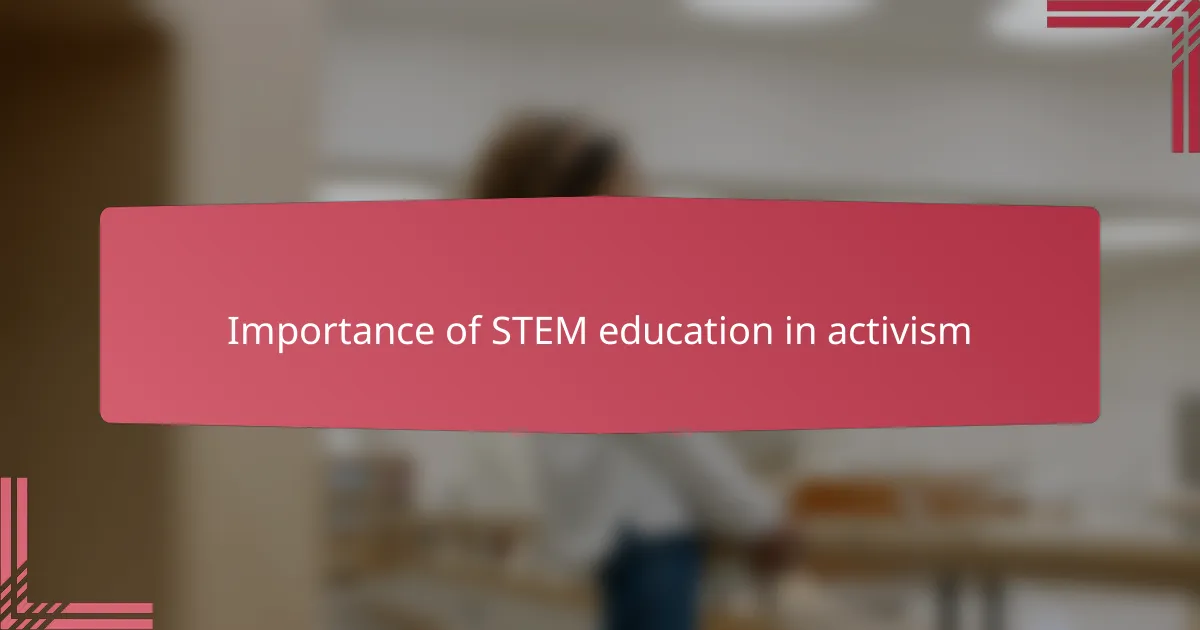
Importance of STEM education in activism
STEM education holds a unique power in activism because it equips students with the tools to analyze problems critically and devise practical solutions. I’ve seen firsthand how hands-on projects in science or engineering open students’ eyes to issues like environmental justice or public health, making activism tangible rather than abstract.
When I guided my students through building simple water filtration systems, their understanding of clean water access transformed from a distant idea to an urgent, solvable crisis. Doesn’t it make a difference when learning moves beyond theory into real-world impact?
STEM skills also democratize activism by giving students from all backgrounds the confidence to innovate and lead change. Reflecting on this, I realize that fostering such technical competence is not just about career readiness—it’s about empowering the next generation to shape a more equitable future.
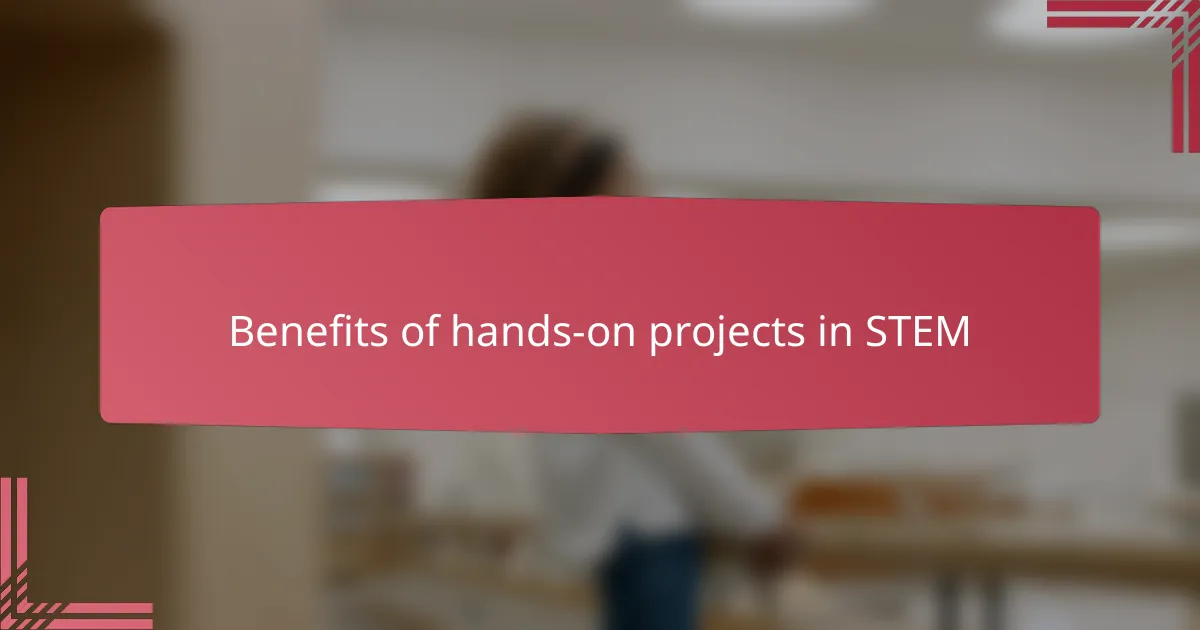
Benefits of hands-on projects in STEM
Hands-on projects in STEM have this incredible way of making abstract concepts click in a way lectures rarely do. I recall a moment when my students built their own simple circuits—they lit up with excitement as a bulb glowed from their own connections. Doesn’t witnessing that spark of understanding feel like the core of teaching?
Beyond just understanding, these projects boost problem-solving skills that are essential not only in STEM but in tackling real-world issues. When students tinker, troubleshoot, and iterate, they develop resilience and creativity—qualities I believe are vital for activist changemakers. Have you noticed how much more invested students become when they can physically manipulate materials instead of passively listening?
What truly stands out to me is the collaborative spirit hands-on STEM work fosters. I’ve often seen students who rarely speak up find their voice through teamwork on a shared project. Isn’t it powerful to see learning become a community effort, strengthening both knowledge and social bonds?
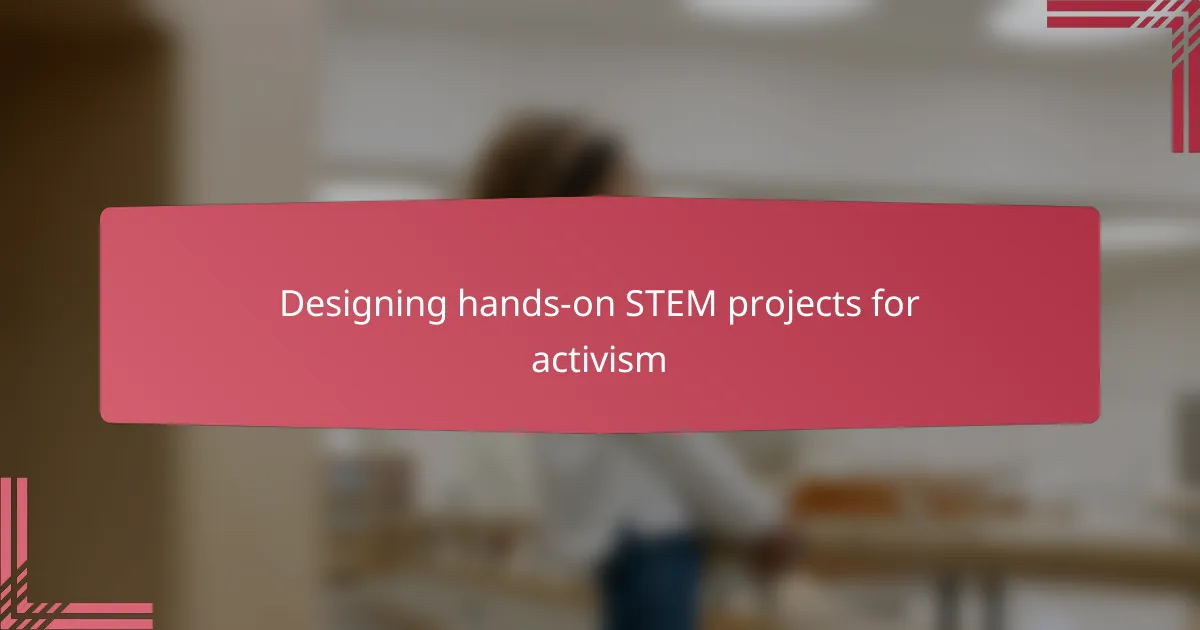
Designing hands-on STEM projects for activism
Designing hands-on STEM projects for activism means crafting experiences where students don’t just learn concepts but grapple directly with issues that matter. I remember facilitating a project where my students built solar-powered phone chargers for community centers; their pride wasn’t just in the technology, but in knowing they were addressing energy inequality firsthand. Isn’t that the kind of learning that fuels passion and purpose?
When choosing or creating these projects, I find it crucial to center them on local or global challenges that resonate with students’ lives. For example, working on air quality sensors allowed my students to collect data on pollution in their neighborhood, turning abstract science into urgent action. How much more empowering is it when students see their work contributing to a real conversation beyond the classroom walls?
What I’ve learned is that designing hands-on projects for activism requires a balance between technical skills and social awareness. It’s not enough to just build or code; students need to reflect on the “why” behind their creations. I often ask my class, “Who benefits from this project? How does it address injustice?” These questions open up deeper dialogue and transform STEM from a set of tools into a means for meaningful change.
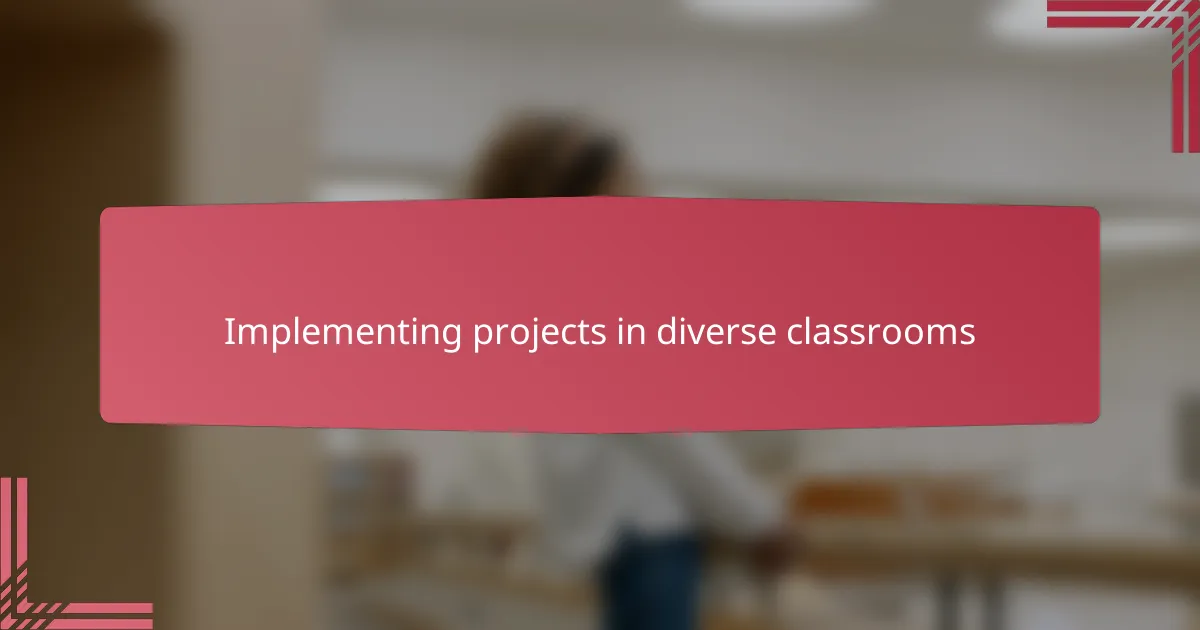
Implementing projects in diverse classrooms
Implementing projects in diverse classrooms often means navigating a wide range of backgrounds, experiences, and learning styles. I remember once adapting a robotics project to include culturally relevant themes—it was incredible to see students connect more deeply when the content reflected their own stories. Have you noticed how inclusion can turn a project from a task into a shared journey?
It’s essential to provide multiple entry points so every student can engage meaningfully with STEM projects. I’ve found using flexible roles like researcher, builder, or presenter helps ensure that different strengths shine, creating a richer learning environment. Doesn’t this approach remind us that diversity isn’t a hurdle but a powerful asset in education?
Sometimes, challenges arise when resources or language barriers exist, but I’ve learned that collaboration with students and families often leads to creative solutions. When a bilingual student helped translate project instructions for peers, it not only boosted understanding but also fostered leadership and confidence. Isn’t that the kind of empowerment we want to nurture through hands-on STEM?
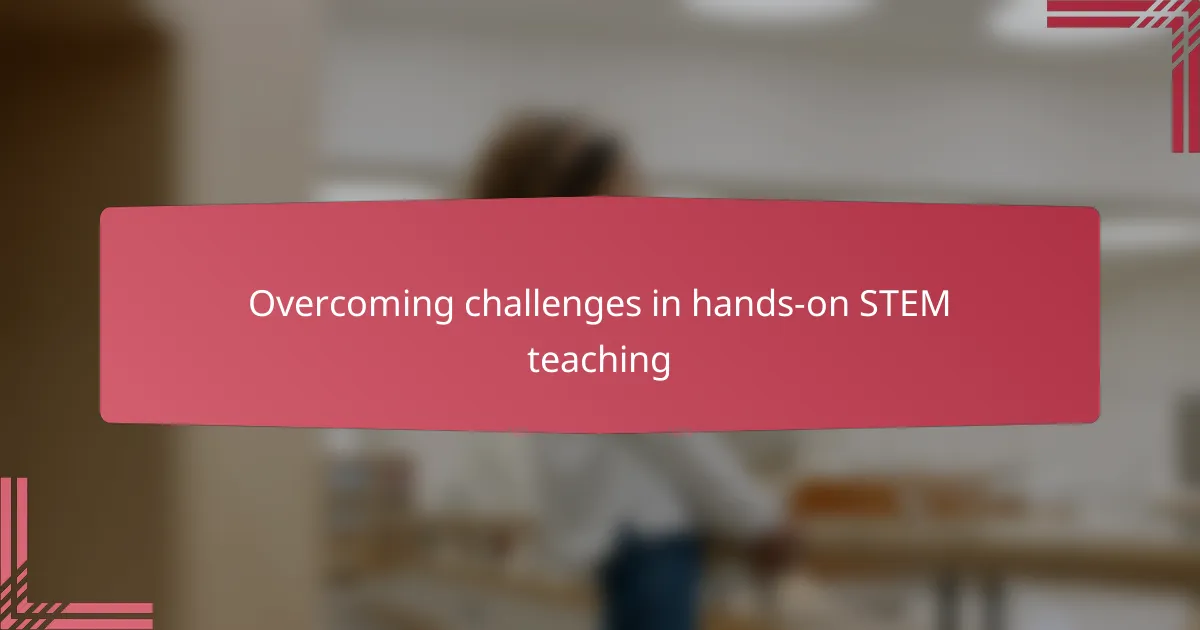
Overcoming challenges in hands-on STEM teaching
Hands-on STEM teaching often comes with the challenge of limited resources. I recall a time when I had just a handful of kits for a class of twenty students, and it felt overwhelming at first. Yet, by encouraging teamwork and sharing, I saw students collaborate in ways that made scarcity a strength rather than a setback. Have you ever noticed how constraints can spark creativity rather than hold it back?
Another common hurdle is managing different skill levels and learning paces among students. I found that breaking down projects into smaller, manageable steps helped keep everyone on track without feeling rushed or left behind. When I asked students to set personal goals within the project, their sense of ownership and confidence grew immensely. Doesn’t it feel rewarding when every learner finds a way to succeed?
Lastly, time can be a big barrier—fitting hands-on projects into a packed curriculum is never easy. But integrating activism themes that connect deeply with students’ realities made every minute count for me. When students are genuinely invested, the energy in the room shifts, and learning happens naturally. Isn’t that the kind of engagement worth fighting for?
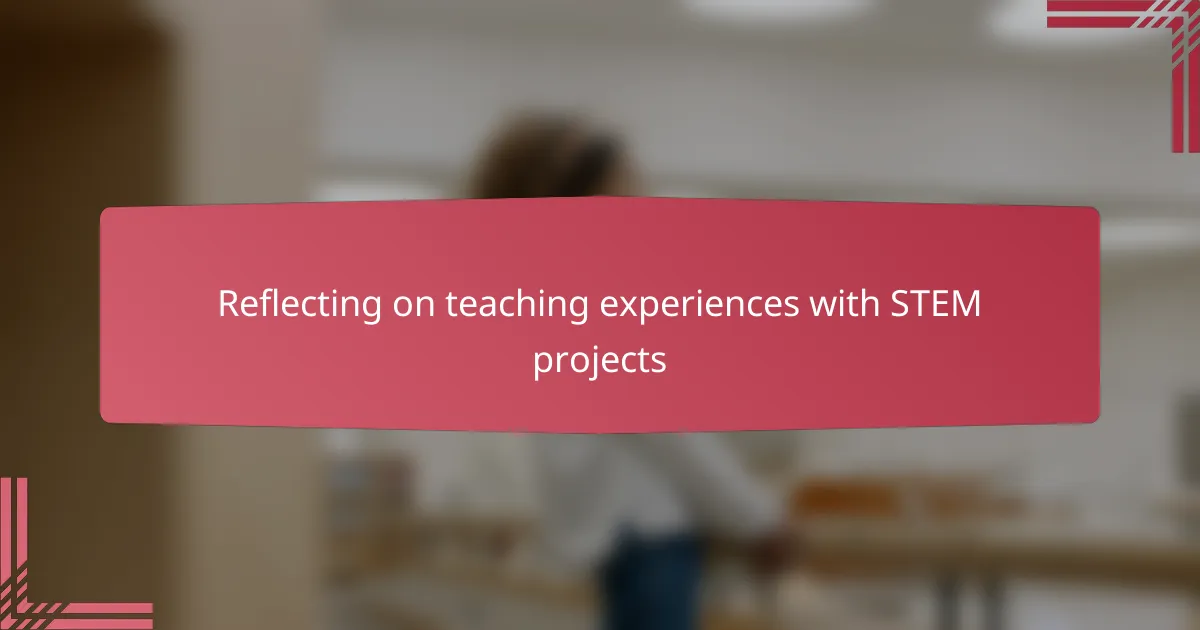
Reflecting on teaching experiences with STEM projects
Reflecting on my experiences teaching STEM through hands-on projects, I realize how these moments often surprise me with the depth of student engagement they spark. Once, during a robotics challenge, a quiet student who rarely volunteered suddenly took the lead in brainstorming solutions—seeing that shift reminded me how powerful active learning can be in revealing hidden strengths. Have you ever witnessed a similar transformation that made you rethink your teaching approach?
Each project also offers a snapshot of how students connect theory with reality. I remember guiding my class through designing a simple environmental sensor, and the questions they asked about pollution went beyond science—they wanted to understand its impact on their own neighborhood. This showed me that hands-on STEM isn’t just about facts; it invites empathy and critical thinking, which are essential for activist education.
At times, reflecting on setbacks is equally important. I once underestimated how tricky a project’s technical steps would be, and watching students struggle made me rethink how I scaffold learning. But through that challenge, I saw resilience grow as they persisted together, reminding me that struggle is not a sign of failure but a catalyst for deeper understanding. Doesn’t that encourage us to embrace imperfection as part of meaningful STEM teaching?